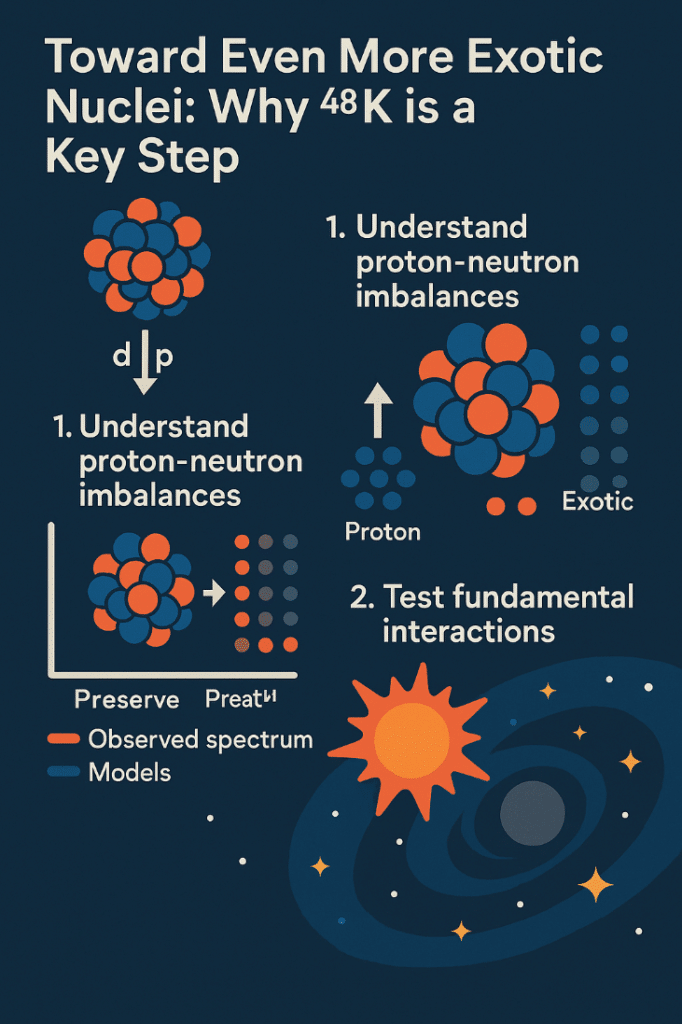- Homepage
- >
- Scientists
- >
- News & Highlights
- >
- 2025
- >
- Towards even more exotic nuclei: why ⁴⁸K is a key step
Towards even more exotic nuclei: why ⁴⁸K is a key step
An international collaboration led by Surey University and LPC Caen has carried out an experiment to study the structure of 48K using the neutron transfer reaction: ⁴⁷K(d,p)⁴⁸K at GANIL. Thanks to the MUGAST+AGATA+VAMOS setup, nine new bound quantum states have been observed for the first time in the ⁴⁸K, with the determination of spins and parities as well as their spectroscopic factors. These measurements probe the nuclear structure of 48K, examining how protons and neutrons interact, particularly in the very special and poorly understood case between the proton (s₁/₂) and neutron (fp) orbitals, around the famous ‘magic number’ N = 28. This highly accurate result is a key step towards modelling even more exotic nuclei such as the isotopes of 44S and 42Si, the first spectroscopic measurements of which were carried out at GANIL almost 20 years ago. A long quest in the study of magic numbers, the pillars of atomic nucleus modelling.
🎯 The experiment in a nutshell
The atomic nucleus is a microcosm where protons and neutrons are organised according to strict quantum rules. The collaboration focused on a key isotope: potassium-48 (⁴⁸K), located just after the ‘magic number’ of neutrons N = 28, a quantum configuration reputed to be very stable in the structure of the atomic nucleus. To create ⁴⁸K, radioactive ions of ⁴⁷K are produced by the SPIRAL1 complex at GANIL and accelerated by the CIME cyclotron before bombarding a thin target of deuterium, a heavy isotope of hydrogen. The so-called (d,p) reaction then allows a neutron to be added to the nucleus, creating ⁴⁸K, while a proton is ejected. By measuring both the protons and the gamma rays emitted – using the state-of-the-art MUGAST+AGATA+VAMOS setup – the team identified for the first time the energy levels of the produced 48K. What makes the study important is that it targets states created by the specific interaction between a proton in the s₁/₂ orbit and a neutron in the fp-type orbits. This coupling gives access to new states in ⁴⁸K hitherto unknown. The results are compared with two popular theoretical models: SDPF U and SDPF-MU. While these models partially reproduce the observed levels, they clearly deviate for the ground state and overestimate the spectroscopic factors. This indicates that the proton-neutron interactions between the ‘s’ and ‘d’ orbitals are poorly understood in these models. This study therefore highlights the limitations of current models for describing lighter and more exotic nuclei, and paves the way for improvements in our understanding of nuclear forces around the neutron number N = 28, in particular towards the deformation island first identified at GANIL 20 years ago in the 42Si isotope.
📈 The key discoveries of this experiment
This experiment discovered new states in the ⁴⁸K from simultaneous measurements of energies and effective cross sections (the probability of reaction). From these observables, a quantity called the spectroscopic factor (corresponding to the probabilities of the neutron being in such and such an orbit) is extracted for energy levels in the 48K. These results shed light on the evolution of the nuclear structure in the region around N = 28, the magic number established at the beginning of the 20th century, and the new magic numbers, such as N = 32 and N = 34, discovered progressively over the last few decades at modern heavy ion accelerators.
🌍 Why it’s useful
The ⁴⁸K has 19 protons and 29 neutrons: it is an asymmetric nucleus, with many more neutrons than protons. It is a ‘neutron-rich’ isotope. This type of configuration is common in the exotic nuclei physicists are trying to explore at facilities such as GANIL (France), FAIR (Germany) and RIKEN (Japan). By studying nuclei such as ⁴⁸K, one have gained a better understanding of how the forces change when neutrons are added, especially above certain ‘magic numbers’. These results make it possible to refine nuclear models, i.e. improve our ability to better predict the structure and stability of the most exotic nuclei that are difficult to access today because of the experimental difficulty of simply producing them in the laboratory. In this context, the study of the slightly less exotic nucleus of ⁴⁸K acts like a magnifying glass on the fundamental mechanisms that govern highly exotic neutron-rich nuclei. As physicists move further away from stable nuclei (those found naturally on Earth), nuclear forces become difficult to model. Targeted, precise and relevant measurements are needed to improve models and our understanding of the atomic nucleus. The 48K meets this objective.
The results show that current models overestimate the contributions of certain configurations (particularly the quantum 1- states). This means that the interactions between protons and neutrons in certain orbitals are poorly described. If this is not corrected, predictions for even more neutron-rich nuclei (such as those close to the ‘drip line’ – the limit beyond which nuclei can no longer exist) will be wrong. In other words: ⁴⁸K is a decisive test for validating or rejecting the models that are then used to predict the structure of heavier and rarer nuclei.
This results also has an impact on our understanding of nucleosynthesis in stars, particularly the r process (rapid neutron capture), which forms the heavy elements in supernovae or neutron star collisions. However, this process involves very exotic nuclei that cannot be observed directly – they have to be predicted theoretically. If the models are poorly calibrated (as shown by the ⁴⁸K study), this affects our ability to correctly model the origin of the elements in the universe.
The results of this experiment have been published in the prestigious journal Phys Rev Lett. : C. J. Paxman et al Phys. Rev Lett. 134, 162504 (2025) https://doi.org/10.1103/PhysRevLett.134.162504

